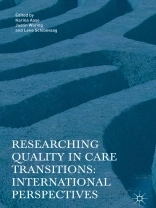This book is concerned with the complexities of achieving quality in care transitions. The organization and accomplishment of high quality care transitions relies upon the coordination of multiple professionals, working within and across multiple care processes, settings and organizations, each with their own distinct ways of working, profile of resources, and modes of organizing. In short, care transitions might easily be regarded as complex activities that take place within complex systems, which can make accomplishing high quality care challenging. As a subject of enquiry, care transitions are approached from many research, improvement and policy perspectives: from group psychology and human factors to social and political theory; from applied process re-engineering projects to exploratory ethnographic studies; from large-scale policy innovations to local improvements initiatives. This collection will provide a unique cross-disciplinary and multi-level analysis, where each chapter presents a particular depth of insight and analysis, and together offer a holistic and detail understand of care transitions.
Tabla de materias
Part 1, Introduction.- Chapter 1:Crossing boundaries: Quality in care transitions?; Karina Aase, Lene Schibevaag and Justin Waring.- Chapter 2: Studying complex care transitions from a qualitative perspective; Kristin A. Laugaland, Dagrunn N Dyrstad, Karina Aase.- Chapter 3: Studying complex care transitions from a quantitative perspective; Line Kildal Bragstad, Christina Foss.- Part 2, Patient perspective.- Chapter 4: Patient experiences of safety in care transitions; Jason Scott.- Chapter 5: The role of next-of-kin in care transitions; Dagrunn Nåden Dyrstad, Marianne Storm.- Chapter 6: Connecting with older people: multiple transitions in same place; Fiona Marshall.- Part 3, Contexts and characteristics.- Chapter 7: Pre-hospital transitions and emergency care; Jason Scott, Darren Flynn, Katharine Chan, Mark-Alexander Sujan.- Chapter 8: The role of professionals’ competencies in care transitions; Marianne Storm.- Chapter 9 : The knowledge brokering situations of care transitions; Simon Bishop, Justin Waring.- Chapter 10: Care Transitions in a federated landscape; Frances Rapport, Jeffrey Braithwaite, Rebecca Mitchell, Johanna Westbrook, Kate Churruca.- Part 4, Improving care transitions.- Chapter 11: In-hospital handovers: A context-specific design process; Doris Østergaard, Marlene D Madsen, Lene F Petersen, Inger Margrethe Siemsen.- Chapter 12: Can an elephant crack a nut with a sledgehammer? How physicians cross boundaries; Antoinette de Bont, Dorien Zwart.- Chapter 13: The Meeting Point: Organizing for knowledge transfer; Randi Heskestad, Karina Aase.- Chapter 14: The role of integrated care and population health; Oliver Groene, Alexander Pimperl, Helmut Hildebrandt.- Part 5, Conclusions.- Chapter 15: Deconstructing quality in care transitions; Justin Waring, Karina Aase.
Sobre el autor
Karina Aase, is the Centre Director of SHARE, Centre for Resilience in Healthcare, within the Department of Health Studies at the University of Stavanger, Norway, where she is also Professor of Patient Safety.
Justin Waring is Professor of Organisational Sociology and Associate Dean for Research at Nottingham University Business School, UK where he founded the Centre for Health Innovation, Leadership & Learning (CHILL), and in 2013 was awarded a Health Foundation Improvement Science Fellowship.
Lene Schibevaag has a background as physiotherapist with a master in Societal Safety from the University of Stavanger, Norway and is Research Coordinator at SHARE, Centre for Resilience in Healthcare, Department of Health Studies at the University of Stavanger, Norway.












